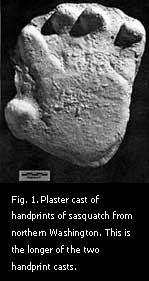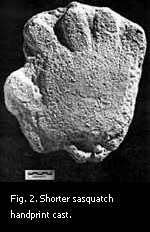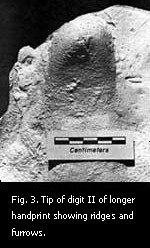Two plaster casts have been obtained of handprints of the reputed Sasquatch. The prints measure more than half again greater than normal human hands and are relatively very broad. The thumb is non-opposable and there is correspondingly no elevation of the thenar eminence. Characteristics of these handprints, as with associated footprints, suggest their makers were gigantic hominids.
The sasquatch, or bigfoot, is an often reported, but thus far unverified bipedal primate which supposedly lives in western North America. Descriptions by eye-witnesses are of hairy, man-like forms eight or nine feet tall. The most tangible evidence of the species until recently has been their human-like footprints which have been measured, photographed, and cast in plaster in large numbers.
During the summer of 1970, handprints of two of these animals were photographed and plaster casts of them were made by Ivan Marx, a game guide in northeastern Washington state. Marx loaned the original casts to the writer who then made latex molds from them in order to produce exact duplicates for further study. The copies are illustrated here rather than the original casts so that they would have a uniform color.
The authenticity of these casts is impossible to demonstrate by any direct means. That they were not faked is strongly indicated by the fact that these are only the best two out of several prints that were cast, and that photographs of many more were taken. For a hoaxer to have made them all would have involved a considerable amount of difficulty.
The two good prints described here are both of left hands which were imprinted flat into soft ground showing all digits and outlines of the palms. The longer print shows all digits somewhat flexed and their tips were well indented into damp ground. It measures 292 mm. in actual length to the end of digit III, but the hand would be closer to 300 mm. long if fully extended.
 Its palm is 174 mm. wide at the distal ends of the metacarpals, thumb excluded. The shorter print is more nearly flat with a length of 265 mm. and a breadth of 185 mm. Only the second digit of this hand is slightly flexed. Other dimensions not given here can be taken by the reader from the photographs, Figs. 1 and 2.
Its palm is 174 mm. wide at the distal ends of the metacarpals, thumb excluded. The shorter print is more nearly flat with a length of 265 mm. and a breadth of 185 mm. Only the second digit of this hand is slightly flexed. Other dimensions not given here can be taken by the reader from the photographs, Figs. 1 and 2.
Footprints corresponding to the long hand are almost 500 mm. long (19½ inches). The shorter hand is reportedly associated with 432 mm. Footprints (17 inch), cast copies of which are also in the writer’s possession. It can be seen that the size ratio of hand to foot is similar to that encountered in man.
The hands which supposedly made these imprints can be compared and contrasted with those of recent man in several particulars. Most obvious is their immense size — in linear dimensions they are more than half again greater than an average European’s hand. My own hand, of average proportions but quite large, measures 205 mm. in length and 95 mm, in breadth. The sasquatch hands are thus 46.4% and 29.3% longer than mine, and 83.2% and 94.6% broader, giving a mean of over 63% greater in these two dimensions. This is at least commensurate with claimed stature estimates.
The hands are relatively very broad. My own hand has a breadth which is 46.4% of its length, while the corresponding figure for the long sasquatch hand is 58.1% and for the shorter hand it is 69.8%. The major difference between the two is in their finger lengths. Actually, the short hand has a larger palm, both in length and breadth, while the third digit appears to be only 33% of the total hand length if the measurement is correct. In the long hand, that digit clearly makes up 42% of its length, a quite human proportion.
The fingers are well separated from each other and the divisions between their phalangeal segments can be seen in several cases, especially in digits II and V of the longer hand. The fingers are all relatively broad, especially at their tips, and are nearly the same size as one another within the same hand. There is very little decrease in length and breadth from digit III to digit V as in man. This relative unifomity in finger sizes is interestingly matched by a near uniformity in toe sizes as well.
Finger positions are also somewhat unusual, and in the same way in each hand. Only digit V is clearly extending in a straight line from its metacarpal. The other three fingers fan out considerably so that digit II appears to be strongly abducted toward the thumb from what should be its more normal, or human, position. In other words, the long axes of all four fingers meet at, and radiate from, a point at the base of the palm, not in the center line of the hand, but rather on its edge under the fifth digit (the hypothenar eminence). The significance of this is not evident.
 Probably the most unexpected feature indicated for these hands is the apparent non-opposability of the thumb, which is clearly evident in both individuals. In the short hand the palmar surface of the thumb is quite flat and is in the same plane as all of the fingers. In the larger hand the thumb flexion parallels that of the other digits in digging into the ground. Still, these thumbs both separate from near the base of the palm and extend out to the side in a quite human direction.
Probably the most unexpected feature indicated for these hands is the apparent non-opposability of the thumb, which is clearly evident in both individuals. In the short hand the palmar surface of the thumb is quite flat and is in the same plane as all of the fingers. In the larger hand the thumb flexion parallels that of the other digits in digging into the ground. Still, these thumbs both separate from near the base of the palm and extend out to the side in a quite human direction.
The thenar pad, or eminence, at the base of the thumb is virtually non-existent. In this eminence would be found the major muscles (abductor pollicis brevis, opponens pollicis, and flexor pollicis brevis) which in man pull the opposable thumb in various ways across the palm. Since in this case the thumbs do not oppose, it is consistent that the thenar area is not thickened. It would require someone quite familiar with the anatomy of the human hand to make the connection between a non-opposable thumb and an absence of a thenar eminence. This tends to support the authenticity of these handprints. Ivan Marx has no known training in human anatomy, and no other person could have planted the many impressions without leaving his own track for Marx to observe.
On the larger handprint, along the distal segment of digit II, there can be seen a series of parallel ridges and furrows. These run perpendicularly to the long axis of the finger in a position corresponding to human fingertip prints of the arch type (Fig. 3). The ridges are almost 2 mm. apart and are more closely spaced toward the tip of the finger. This spacing is considerable, being just twice the amount found in the ridges of my own fingers at the same location. One could suggest another possible explanation of these ridges: that they are the grain in the piece of wood from which this hand was carved. If this were the case, the ridges should be narrower than the furrows, however, the reverse is the case here as with human fingerprints.
A transverse crease can be seen in the palm of the longer cast under digits III to V. Other palm creases are vaguely indicated, but their identification is uncertain.
There are many other irregularities in the cast’s surfaces which cannot be identified in terms of human anatomy. Most of these irregularities no doubt resulted from unevenness in the dirt into which the hands were pressed, and also from various particles which fell into the impressions before the casts were made.
Both hands give the appearance of being very flat in palms and fingers with all margins turning abruptly. This may result from callus formation which is especially prominent around all of these margins. The same kind of abrupt edges occur in the footprints associated with these hands. The larger individual shows less of this callousing in both hand and foot.
In most respects these handprints show about what might be expected if one grants the reality of the creatures reportedly seen making the gigantic footprints. The only totally unexpected trait is the non-opposable thumb. The hand strongly suggests one designed for digging into the ground and for raking berries from bushes rather than being primarily for manipulating objects. Flexing all five digits in the same direction would best facilitate the suggested functions. Heavy callousing, including along all margins, would also be expected to follow from such uses.
 Another peculiarity, not indicated in the illustrations here, is the evident rigidity of the hands. I have examined three different casts of imprints by the same left hand of the larger individual, and photographs of still more mpressions of both of his hands. In all cases the fingers and thumb are in very nearly, though not exactly, the same relative positions and degrees of flexion. Photographs of more imprints of the shorter hand indicate the same thing. In contrast, their footprints (from numerous casts and photographs) often show variations in toe positions. Unlike in man, finger mobility is not greater than that of the toes, and is possibly less.
Another peculiarity, not indicated in the illustrations here, is the evident rigidity of the hands. I have examined three different casts of imprints by the same left hand of the larger individual, and photographs of still more mpressions of both of his hands. In all cases the fingers and thumb are in very nearly, though not exactly, the same relative positions and degrees of flexion. Photographs of more imprints of the shorter hand indicate the same thing. In contrast, their footprints (from numerous casts and photographs) often show variations in toe positions. Unlike in man, finger mobility is not greater than that of the toes, and is possibly less.
A final item of interest is the relative length of the thumb which differs between the two hands. The shorter one has a relative thumb length which is comparable to man’s. The longer hand has a relatively shorter thumb, even after a liberal allowance is made for unflexing it. No figures can be given with any accuracy because the proximal measuring point is too vaguely located. This contrasts markedly with the finger lengths; the short hand having both the shortest fingers and the longest thumb. Such a high degree of individual ariation might be expected to occur in a very sparse population of any large mammal. The casts illustrated here are available for examination be serious investigators by contacting me in Pullman, Washington.
An interesting problem is created by the publication of this description. Future reports of handprints, with photographs or plaster casts, might be suspected of being faked if they show all the characteristics described here. However, any experienced hunter or game guide should have no difficulty recognizing imprints from a live animal as opposed to impressions made by solid, rigid forms.
From: Northwest Anthroplogical Research Notes 5(2), Fall 1971.
